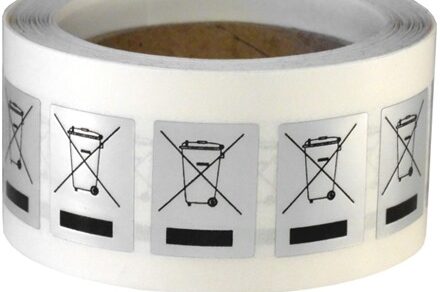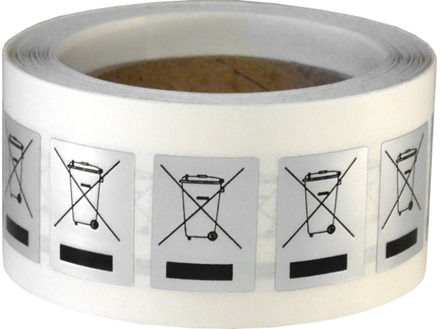
Electronics and batteries must be marked
When you sell products subject to producer responsibility you are obligated put on a pictogram to communicate that the product must be handled in a certain way. Electronics and batteries must not be discarded in an ordinary waste bin; therefore, you must put a pictogram of a crossed-out wheeled bin on the products.
Marking of batteries
Under certain conditions, batteries are subject to requirements for labelling of heavy metals and capacity. Read more about calculation methods, emission limit values, production of labels, and information text.
Marking of single-use plastic
Products regulated by the rules on single-use plastics are subject to their own labeling requirements,
with each EU country having labels in its own language.
Marking of packaging
The symbols and abbreviations for packaging materials are legally required in some EU-member states, but voluntary in Denmark.
The symbol indicates that the product must not be discarded with residual waste in the ordinary waste bin; it must be taken to/picked up at specific collection points or recycling centres to be reused or recycled.
Is marking a requirement?
With a few exemptions all batteries and electrical and electronic equipment put on the market in the EU must be labeled with this pictogram. So marking is mandatory under our legislation.
How to mark your products
The electrical product and any batteries must bear the symbol of a
- crossed-out wheeled bin
- Identification label of your business such as company name or brand
Black bar or not?
If your product was placed on the market after 13 August 2005, you can do one of two:
- State the date the product was placed on the market. or
- Add a black bar under the crossed-out wheeled bin symbol
These inscriptions must be printed on the product itself and should be permanent, clearly visible, and readable. Minimum size is 7 mm. Only if the product’s size is too small or if its function is affected by the marking the inscription could be printed on the packaging, the instructions, or the warranty leaflet and not on the product itself.
Standard explanatory text
The meaning of the crossed-out wheeled bin symbol must appear from sales and information materials along with information about where the private or professional end-user can deliver his/her end-of-life electronics, batteries, and accumulators.
The Danish Environmental Protection Agency has prepared a standard text to be used by producers to inform their end-users about marking and the producer responsibility system.

Marking
Danish Environmental Protection Agency’s standard text for electronics
Extract in Danish: "Elektrisk og elektronisk udstyr (EEE) indeholder materialer, komponenter og stoffer, der kan være farlige og skadelige for menneskers sundhed og for miljøet, når affaldet af elektrisk og elektronisk udstyr (WEEE) ikke bortskaffes korrekt. Produkter, der er mærket med den overkrydsede skraldespand', er elektrisk og elektronisk udstyr. Den krydsede skraldespand symboliserer, at affald af elektrisk og elektronisk udstyr ikke må bortskaffes sammen med usorteret husholdningsaffald, men skal indsamles særskilt....” Read more about requirements for marking and standard text:
Memo on Marking of equipmentStandard
An international standard EN 50419 has been drawn up in connection with the technical specifications of the pictogram, just as graphic files for the production can be acquired from the Danish Standards Association.
Marking of batteries
Chemicals and capacity labelling
Producers or importers of batteries must mark their products with the crossed-out wheeled bin, just like for electronic equipment. In addition, there are requirements for labelling of heavy metals and capacity.
Memo on Marking of batteries